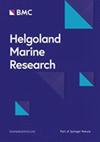In the Asia-Pacific region, the COI DNA test revealed the divergence of the bivalve mollusc Mactra chinensis into three species; can these species be distinguished using shell coloration and sperm structure?
4区 地球科学
Q2 Agricultural and Biological Sciences
引用次数: 6
Abstract
According to COI DNA barcoding testing, the marine bivalve mollusc Mactra chinensis, which is native to the Asia-Pacific region, diverged into three species. These species were preliminary characterized as M. chinensis COI clade I, M. chinensis COI clade II and M. chinensis COI clade III. To find out whether it is possible to morphologically distinguish samples representing genetic clades, we examined the color of the shells and the structure of the spermatozoa. It was found that the number of detected coloration types exceeds the number of detected species. In addition, it was shown that individuals belonging to the same genetic clade can have shells of different colors. Consequently, it is impossible to choose one type of shell coloration as a species-specific trait. For sperm, the sperm morphological patterns found in each of the three species are consistent with the M. chinensis sperm model described in previous reports. However, the single sperm variant is also not applicable to discriminate between species derived from M. chinensis, since heterogeneous variants of spermatozoa differing in the length of the acrosomal rod were found. We hypothesized that genetic divergence of species could cause a shift towards predominance of one of the sperm variants, and that species-specific sperm morphs could be quantitatively dominant in molluscs belonging to different clades. However, the dominant sperm morphs were the same in COI clade I and COI clade III. Thus, dominant sperm morphs are useless as species-specific traits. However, shell color and sperm parameters are specific to different geographic regions, and it seems that unique environmental factors can determine shell color and sperm morphology. As a result, both shells and spermatozoa can be used to distinguish the geographical forms of M. chinensis, regardless of the belonging of the forms to a particular genetic clade. Here we propose the introduction of geographic identifiers, in which the shell color and parameters of sperm sets are used as morphological criteria to determine the geographical origin of mollusc specimens belonging to the M. chinensis species complex.在亚太地区,COI DNA测试显示双壳类软体动物Mactra chinensis分化为3种;这些物种可以通过外壳颜色和精子结构来区分吗?
根据COI DNA条形码测试,原产于亚太地区的海洋双壳软体动物Mactra chinensis分化为三个物种。这些物种初步鉴定为中国血吸虫COI枝I、中国血吸虫COI枝II和中国血吸虫COI枝III。为了找出是否有可能在形态学上区分代表遗传进化支的样本,我们检查了外壳的颜色和精子的结构。结果发现,检测到的颜色类型数量超过了检测到的种类数量。此外,研究表明,属于同一遗传枝的个体可以有不同颜色的外壳。因此,不可能选择一种类型的外壳颜色作为物种特有的特征。就精子而言,在这三个物种中发现的精子形态模式与先前报道中描述的M. chinensis精子模型一致。然而,单精子变异也不适用于区分中华绒螯虾的物种,因为发现了顶体杆长度不同的精子异质变异。我们假设物种的遗传差异可能导致一种精子变体的优势转变,并且物种特异性精子形态可能在属于不同进化支的软体动物中具有数量优势。然而,COI进化支I和COI进化支III的优势精子形态是相同的。因此,优势精子形态作为物种特有的特征是无用的。然而,贝壳颜色和精子参数是特定于不同地理区域的,似乎独特的环境因素可以决定贝壳颜色和精子形态。因此,无论是壳还是精子都可以用来区分中华m.s chinensis的地理形态,而不管这些形态是否属于特定的遗传进化枝。在此,我们建议引入地理标识符,以贝壳颜色和精子组参数作为形态标准来确定中华m.s chinensis种复合体软体动物标本的地理来源。
本文章由计算机程序翻译,如有差异,请以英文原文为准。
求助全文
约1分钟内获得全文
求助全文
来源期刊

Helgoland Marine Research
地学-海洋学
自引率
0.00%
发文量
0
审稿时长
6-12 weeks
期刊介绍:
Helgoland Marine Research is an open access, peer reviewed journal, publishing original research as well as reviews on all aspects of marine and brackish water ecosystems, with a focus on how organisms survive in, and interact with, their environment.
The aim of Helgoland Marine Research is to publish work with a regional focus, but with clear global implications, or vice versa; research with global emphasis and regional ramifications. We are particularly interested in contributions that further our general understanding of how marine ecosystems work, and that concentrate on species’ interactions.
 求助内容:
求助内容: 应助结果提醒方式:
应助结果提醒方式:


